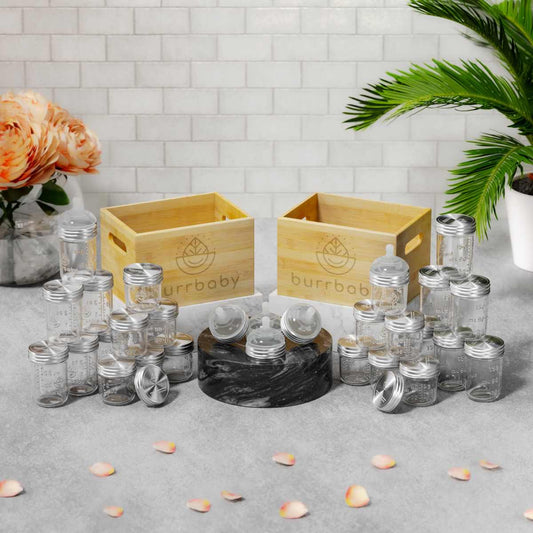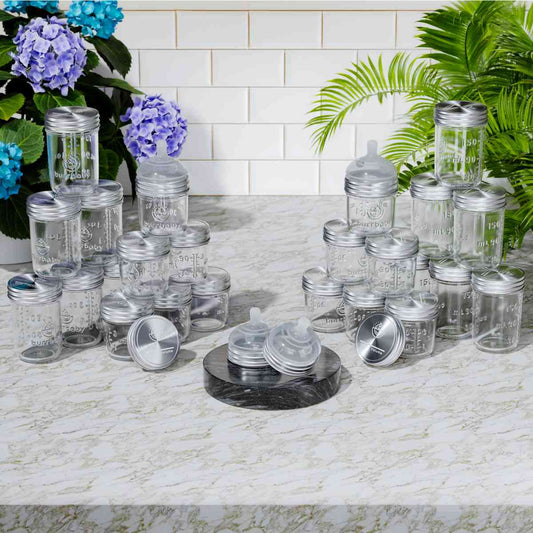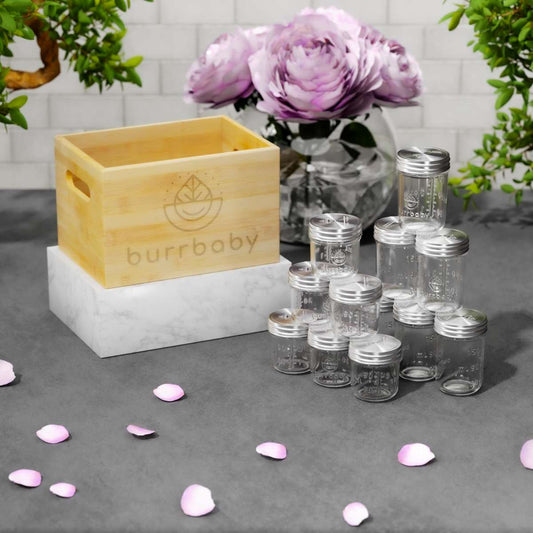Having safe and secure breastmilk storage solutions can impact your baby’s well-being and shouldn’t be overlooked. If you’ve been contemplating using glass containers for breast milk storage, you're in the right place.
In the following article, we will discuss various aspects that make glass containers for breastmilk storage and glass baby bottles the preferred choice for health-conscious, eco-friendly parents.
Article Overview
- Introduction to glass breast milk storage
- The Health Benefits:
- The Practical Advantages Of Glass Storage
- Choosing the Right Glass Storage Containers
- Environmental Advantages and Sustainability
- Tips for Storing Breast Milk in Glass Containers
- Organizing Glass Breast Milk Storage Containers
At Burrbaby, we're dedicated to being a part of a healthier world for your children. We hope to accomplish this through our zero-plastic glass breast milk storage containers and bottles. These completely non-toxic, sustainable choices protect your baby's health and our planet.
Introduction to Glass Breast Milk Storage
Breast milk is one of the healthiest sources of nutrition you can provide babies with. If you’re looking for an alternative to plastic containers or bags when storing breast milk, glass storage could be the answer.
Glass has many advantages over other materials when it comes to milk and food storage for your baby. Glass doesn’t contain bisphenols (BPA for example), phthalates, polypropylenes, PFAS or other synthetic chemicals as many plastics do, so there is no risk of harmful toxins leaching into your baby’s food. You also don't have to worry about microplastics shedding into your breast milk either.

Plus, unlike plastic bottles and bags, which need replacing every time or every few months due to wear and tear, glass containers are built to last, which is more eco-friendly and saves you money.
The American Academy of Pediatrics recommends replacing plastic bottles every 3-6 months due to degradation of materials which can make their way into the milk. Additionally, plastic is very prone to scratching which makes a perfect home for bacteria.
If you’re looking for a safe, reliable, and sustainable way to store your baby’s precious breast milk without compromise, investing in a high-quality glass breast milk storage and feeding bundle like the ones provided by Burrbaby could be what you’ve been searching for.
The Health Benefits of Glass Breast Milk Storage and Bottles
When storing breast milk and using bottles to feed your baby, glass is the clear choice to ensure no chemicals or microplastics leak into your milk. It preserves the quality and flavor of your baby’s food while avoiding many potentially hazardous materials in plastic containers. Here are a few of the chemicals to look out for in plastics:
Phthalates: These chemicals found in certain plastics have been linked to hormone disruption, infertility, cancer, and other long-term health issues. Glass containers do not contain phthalates, so you can rest assured that your baby will be safe from any potential harm.
Bisphenols: BPA-free plastic bottles still may have gotten rid of bisphenol A, but other bisphenols still exist which may also pose a risk for disrupting hormones as well as increasing dangers for diabetes, obesity, and heart disease. When one chemical is banned, it just gets replaced by another. Glass does not contain these compounds, making it a far safer option for storing breast milk.
Polypropylene: This type of plastic has been known to leach into liquids stored in them over time.
Microplastics: Breast milk stored in plastic containers can expose babies to microplastics. Microplastic particles, including inflammation and oxidative stress, can harm human health and have even been linked to cancer. Avoiding the exposure of your baby to microplastics is crucial. By choosing safe and sustainable storage options, such as glass containers, this risk can be eliminated.
Glass containers offer peace of mind knowing that what you’re feeding your little one is free from chemicals from plastics that could potentially cause harm down the road. With all these advantages, it makes glass a more and more appealing option.
Additionally, it seems that we never learn the harms of synthetic chemicals until it is too late. It is our philosophy at Burrbaby that just because current plastic bottles have been deemed “safe” doesn’t mean they will be indefinitely, and the convenience of plastic isn’t worth the risk of potential harm to our children.
The Practical Advantages Of Glass Storage: Reuse, Easy Cleaning, Less Odor and Taste Buildup
One of the most practical advantages of glass storage is its reusability. Unlike plastic, which wears out and degrades over time, glass containers are durable and long-lasting. This means you can use them repeatedly without compromising their integrity or the quality of the breast milk stored inside. Not only does this save you money in the long run, but it also contributes to a more eco-friendly lifestyle by reducing the need for disposable containers.

Another practical benefit of glass storage is the ease of cleaning. Glass is non-porous, meaning it doesn’t absorb stains or odors like plastic can. This makes it easier to clean and sanitize between uses, ensuring that your baby’s breast milk remains contaminant-free.
Most glass containers can be safely washed in the dishwasher or by hand with warm soapy water, and they can also be sterilized using a steam sterilizer. The convenience of cleaning glass storage contributes to a more hygienic and efficient breast milk storage process.
Lastly, glass storage reduces the buildup of bacteria, odors and tastes that can sometimes affect the quality of stored breast milk. Since glass is non-porous and resistant to scratches, it prevents the absorption of smells and flavors from its surroundings and previous contents. It also doesn't give as many places for bacteria to live.
This means your baby’s breast milk will remain fresh and untainted, preserving its natural taste and nutritional benefits.
Choosing the Right Glass Storage Containers
Food Safe
When selecting a glass storage container for your breast milk, choosing one specifically designed for this purpose is essential.
Such containers are typically made from high-quality, food-grade glass. In addition, these containers often come with airtight, leak-proof lids to keep the milk fresh and prevent spills during storage and transportation. Burrbaby's come with premium stainless steel lids.
At Burrbaby, we've designed high-quality, food safe breastmilk storage containers and bottles that completely eliminate the use of plastic to maximize the safety and sustainability of the products you use to store breastmilk and feed your baby.
Intentional Design
Choosing a breast milk-specific container also means that they are designed with the unique needs of nursing mothers in mind. Containers should come in various sizes, allowing you to store the right amount of milk for your baby’s needs and should be marked with volume measurements, making it easy to track how much milk you have pumped.
The containers should be freezer and refrigerator safe so you can conveniently go back and forth. Burrbaby’s glass options were designed to be convenient for busy parents. The glass storage containers are stackable and fit inside our FSC-Certified bamboo organization box to keep them safe and organized.
When you’re ready to use the milk to feed your baby, take the container out of the refrigerator or freezer, warm it in a water bath, screw on our bottle conversion nipple, and start feeding! Because they are meant to be used over and over, we gave them a wide neck to make cleaning fast and easy.
Environmental Advantages and Sustainability
Resources Required
Choosing glass breast milk storage over plastic offers several environmental advantages, making it a more sustainable option for eco-conscious parents. Glass containers are recyclable and can be turned into new glass products with minimal loss of quality.

In contrast, plastic recycling is often less efficient, and many plastics end up in landfills or the environment where they take centuries to decompose. Parents can actively contribute to reducing plastic pollution and preserving the planet for future generations by opting for glass storage.
At the end of the lifecycle for glass, even if it does end up in the environment, the glass will eventually get worn down and smashed back into harmless sand!
Reusability
Another environmental benefit of using glass breast milk storage is its ability to be reused. Glass containers are incredibly durable and can withstand repeated use without losing structural integrity. When using plastic breast milk storage bags, you might use hundreds or thousands if you follow the recommendation to use a fresh bag with each pumping session. This is terrible for the environment and creates a large carbon footprint.
Smaller Carbon Footprint
Lastly, glass storage containers have a lower carbon footprint than their plastic counterparts. Glass containers have a much longer life span than plastic, meaning that fewer resources are needed to replace them over time.
This long-term sustainability is crucial in the fight against climate change and helps parents make an environmentally responsible choice when selecting breast milk storage options.
Tips for Storing Breast Milk in Glass Containers: Labeling, Handling, and Cleaning
Here are some tips on labeling, handling, and cleaning glass containers for breast milk storage.
Labeling Breast Milk
Labeling is essential to storing breast milk in glass containers. It helps you keep track of when the milk was expressed and ensures that you use the oldest milk first. To label your containers, use either a dry-erase or permanent marker to write the date, time and volume of expression directly on the glass or lid. Permanent works better, but means you might need finger nail polish remover or ethanol to wipe off.
You may also want to include your baby’s name if the milk is used in childcare. By keeping a clear record of each container’s contents, you can effectively manage your breast milk supply and prevent spoilage or waste.
Burrbaby premium stainless steel lids have fields where you can write date, time and volume right on the lid.
Cleaning Your Glass Breast Milk Containers
Cleaning your glass containers properly is important to maintain a safe and hygienic storage environment for your baby’s breast milk. Before using the containers for the first time, wash them thoroughly with warm, soapy water and rinse well. After each use, clean them promptly to prevent the buildup of milk residue.
We recommend washing by hand, as the dishwasher often leaves a soapy residue you don’t want to expose the baby too. To sterilize your glass containers, use a steam sterilizer for several minutes. Remember to allow the containers to dry completely before filling them with breast milk to prevent bacterial growth.
Read here for more cleaning and caring for glass breast milk storage containers.
Storage
Make sure to handle your breast milk storage containers with care. In the fridge, store the containers on a designated shelf or in a dedicated storage box (like Burrbaby’s FSC-Certified bamboo box), and away from any items that might accidentally knock against them. When freezing breast milk in glass containers, leave enough headspace at the top of the jar to allow for expansion as the milk freezes.
This will help prevent the containers from cracking or breaking under pressure. Yes, plastic is almost indestructible, but it's the chemicals that make it indestructible that can leach into the milk and potentially cause harm to your baby. For us, it's an easy decision to be more careful with the container and have our babies be safe.
Organizing Your Glass Breast Milk Storage
We’ve mentioned this briefly, but a wooden or bamboo box helps organize milk containers and is a nice, elegant solution if we don't say so ourselves. In addition, bamboo boxes are usually durable and long-lasting, so you won’t have to worry about replacing them anytime soon.
Most options for breast milk storage are plastic bins for tossing plastic breast milk storage bags in. Not only do the breast milk bags get disorganized this way, but they aren't safe from cuts or tears.
We don't like the plastic from plastic bins, and we don't like plastic breast milk storage bags, so we'll stick with glass jars and wood or bamboo organization boxes!
Here are 5 more tips for Safe Refrigerator and Freezer Breast Milk Storage
A Benefit Recap and a Plan of Action
As a new parent, deciding which storage methods are best for your baby’s breast milk can be overwhelming. Glass storage has many benefits, making it a great way to maintain your valuable liquid gold. Not only is glass free of synthetic chemicals and microplastics that can make their way to your milk, but it also provides practical advantages such as reuse and easy cleaning.
Ultimately, glass storage offers many benefits that make it the optimal choice for storing breast milk safely and sustainably.
References:
American Academy of Pediatrics. Policy Statement: Breastfeeding and the Use of Human Milk. Retrieved from https://publications.aap.org/pediatrics/article/150/1/e2022057988/188347/Policy-Statement-Breastfeeding-and-the-Use-ofCenters for Disease Control and Prevention. (2020). Proper Storage and Preparation of Breast Milk. https://www.cdc.gov/breastfeeding/recommendations/handling_breastmilk.htm
NIEHS. Phthalates - The Everywhere Chemical https://www.niehs.nih.gov/research/supported/assets/docs/j_q/phthalates_the_everywhere_chemical_handout_508.pdf
World Health Organization. (2014). Bisphenol A (BPA) - Current state of knowledge and future actions by WHO and FAO. https://cansa.org.za/files/2009/10/WHO-Summary-Infosan-Bisphenol-A-Nov2009.pdf
Esmizadeh, E., Tzoganakis, C., & Mekonnen, T. H. (2020). Degradation Behavior of Polypropylene during Reprocessing and Its Biocomposites: Thermal and Oxidative Degradation Kinetics. Polymers, 12(8), 1627. https://www.ncbi.nlm.nih.gov/pmc/articles/PMC7464851/
Prata, J. C., da Costa, J. P., Lopes, I., Duarte, A. C., & Rocha-Santos, T. (2020). Environmental exposure to microplastics: An overview on possible human health effects. Science of The Total Environment, 702, 134455. https://pubmed.ncbi.nlm.nih.gov/31733547/
Accorsi, R., Versari, L., & Manzini, R. (2015). Glass vs. Plastic: Life Cycle Assessment of Extra-Virgin Olive Oil Bottles across Global Supply Chains. Sustainability, 7(3), 2818-2840. https://www.mdpi.com/2071-1050/7/3/2818
Glass Packing Institute. Glass Container Recycling Loop. https://www.gpi.org/glass-recycling-facts
Seltenrich, N. (2015). New link in the food chain? Marine plastic pollution and seafood safety. Environmental Health Perspectives, 123(2), A34-A41. https://www.ncbi.nlm.nih.gov/pmc/articles/PMC4314237/
Geraghty, S. R., Khoury, J. C., Morrow, A. L., & Lanphear, B. P. (2006). Reporting individual test results of environmental chemicals in breastmilk: potential for premature weaning. Breastfeeding Medicine, 1(4), 207-213. https://pubmed.ncbi.nlm.nih.gov/19086823/










